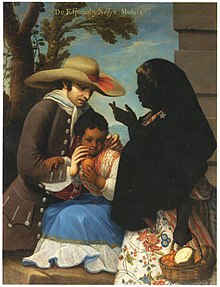
Back Spaans-Amerika Afrikaans أمريكا الهسبانية Arabic Hispanoamérica AST Hispanik Amerikası Azerbaijani Hispanoamèrica Catalan Hispanoamerika Czech Hispanoamerika German Amerika İspanyole DIQ Hispanameriko Esperanto Hispanoamérica Spanish
The region known as Hispanic America (Spanish: Hispanoamérica or América Hispana) and historically as Spanish America (Spanish: América Española) or Castilian America (Spanish: América Castellana) is all the Spanish-speaking countries of the American continent.[1][2] In all of these countries, Spanish is the main language - sometimes sharing official status with one or more indigenous languages (such as Guaraní, Quechua, Aymara, or Mayan) or English (in Puerto Rico),[3] and Latin Catholicism is the predominant religion.[4]
Hispanic America is sometimes grouped together with Brazil under the term "Ibero-America", meaning those countries in the Americas with cultural roots in the Iberian Peninsula.[a] Hispanic America also contrasts with Latin America, which includes not only Hispanic America, but also Brazil (the former Portuguese America) and the former French colonies in the Western Hemisphere (areas that are now in either the United States or Canada are usually excluded).[5]


- ^ All of the following dictionaries only list "Spanish America" as the name for this cultural region. None list "Hispanic America." All list the demonym for the people of the region discussed in this article as the sole definition, or one of the definitions, for "Spanish American". Some list "Hispanic," "Hispanic American" and "Hispano-American" as synonyms for "Spanish American." (All also include as a secondary definition for these last three terms, persons residing in the United States of Hispanic ancestry.) The American Heritage Dictionary of the English Language (3rd ed.) (1992). Boston: Houghton Mifflin. ISBN 0-395-44895-6. Merriam-Webster's Collegiate Dictionary (11th ed.) (2003). Springfield: Merriam-Webster. ISBN 0-87779-807-9. The Random House Dictionary of the English Language (2nd ed.) (1987). New York: Random House. ISBN 0-394-50050-4. Shorter Oxford English Dictionary on Historical Principles (2007). New York: Oxford University Press. ISBN 978-0-19-920687-2. Webster's New Dictionary and Thesaurus (2002). Cleveland: Wiley Publishing. ISBN 978-0-471-79932-0
- ^ "Hispanic America" is used in some older works such as Charles Edward Chapman's 1933 Colonial Hispanic America: A History and 1937 Republican Hispanic America: A History (both New York: The Macmillan Co.); or translated titles that faithfully reproduce Hispanoamérica, such as Edmund Stephen Urbanski (1978), Hispanic America and its Civilization: Spanish Americans and Anglo-Americans, Norman: University of Oklahoma Press. The Cambridge University Press textbook by two distinguished historians of early Latin America, James Lockhart and Stuart B. Schwartz is entitled, Early Latin America: A History of Colonial Spanish America and Brazil 1983.
- ^ "CIA – The World Factbook – Field Listing – Languages". Archived from the original on June 13, 2007. Retrieved 2009-04-11.
- ^ "CIA – The World Factbook – Field Listing – Religions". Archived from the original on June 13, 2007. Retrieved 2009-04-11.
- ^ "Latin America" The Free Online Dictionary (American Heritage Dictionary of the English Language, 2000, 4th ed. Houghton Mifflin Company. Updated in 2003.)
Cite error: There are <ref group=lower-alpha> tags or {{efn}} templates on this page, but the references will not show without a {{reflist|group=lower-alpha}} template or {{notelist}} template (see the help page).
